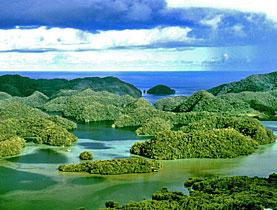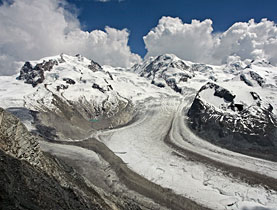Earth’s rainiest zone is creeping northwards

The world's most abundant rainfall zone, near the Equator, has been slowly moving north for more than 300 years, Swiss and international scientists have found.
If the band continues to move, there could be consequences for the one billion people living under it who depend on the rainfall for their freshwater supply, as climate conditions could change.
The research, led by the University of Washington in Seattle in the United States, and including Rienk Smittenberg from the Federal Institute of Technology in Zurich, was published in the July edition of Nature Geoscience.
It concerns the Intertropical Convergence Zone, which is where, just north of the equator, trade winds from the northern and southern hemispheres collide, while heat pours into the atmosphere from the tropical sun. The result is huge rainclouds, which can release as much as four metres of rain a year in some places.
It is described by the scientists as “the most prominent rainfall feature on the planet”.
The research team focused on the central Pacific area – from the western Palau Island to the eastern Galapagos Islands – which lies between three and ten degrees north of the Equator depending on the time of year. They uncovered some surprising results concerning the rain belt.
Molecular CSI
“A few centuries ago when it was cold in Europe and we had the Little Ice Age – the glaciers were much larger in the Alps – this rain belt was much further south in the Pacific than it is today,” Smittenberg told swissinfo.ch.
“Since then it has really moved up to northern latitudes,” he said. According to the study’s calculations, the band has moved around 500 kilometres or 1.4km a year for around 300 years.
Scientists came to their conclusion by digging deep into the mud deposited in lakes on four Pacific islands.
Smittenberg is an organic geochemist, which means looking at the organic remains of algae, plants and bacteria in sediments.
“They record plant life rather like the big fossils such as the dinosaurs, but on the molecular scale. They give us a lot of information,” he explained.
By using these “molecular fossils”, and conducting chemical analysis, the team was able to trace how wet or dry the climate was in previous centuries.
Dramatic shift
On the tiny Washington Island, to the south of Hawaii, which is wet and covered in tropical forest, the change was very visible. Here Smittenberg took samples from a freshwater lake.
“At one metre depth the sediment suddenly turned from topical vegetation debris and algal remains to bacterial remains. They are exactly the same things you currently see on Christmas Island which is 300km south, where it’s currently pretty dry,” he said.
“Additional testing proved that the lake must have been hypersaline, hosting salt-tolerant microbes instead of the freshwater lake that occupies the tropical wet island at present. There we saw a pretty dramatic shift.”
By contrast, the researchers found evidence that the more southern and presently dry Galapagos Islands – of Darwin fame – were much wetter during the Little Ice Age.
Why the rain band has moved is still under debate, said Smittenberg.
It most likely has to do with the amount of solar radiation, or heat, that the Earth receives, he said. The Earth gained less of this radiation during the Little Ice Age of 1400-1850, and it is speculated that this may have caused the zone to hover closer to the Equator until the radiation increased.
The future
The Washington scientists are now looking into what might happen in the future.
Julian Sachs, associate professor of oceanography at the university, said in a statement that if the 1.4km a year shift were to continue, “the Intertropical Convergence Zone will be 126km north of its current position by the latter part of this century”.
This means that wet areas on Pacific Islands could become dry and vice versa, he added. Hard hit would be those relying on rain belt rainfall as a source of freshwater, because many have no groundwater supplies.
People who live further afield in the tropics might also be affected by the changes because the band shapes atmospheric circulation patterns throughout the world, Sachs said.
In addition, global warming could accelerate the situation. The authors say that the findings suggest, “that increasing greenhouse gases could potentially shift the primary band of precipitations in the tropics with profound implications for the society and economies that depend on it”.
Isobel Leybold-Johnson in Zurich, swissinfo.ch
“Southward movement of the Pacific intertropical convergence zone AD 1400–1850” was published in the July edition of Nature Geoscience.
Previous measurements on the topic in other studies had previously taken place on or near land and were less clear as they are influenced by topography and the seasons. The new study focused on an area with less land and was the first time that the rain band was assessed over the whole tropical Pacific, from west to east.
The study covered and involved field work form lakes and lagoons on the Palau,Washington, Christmas and the Galapagos Islands.
Co-author Rienk Smittenberg was part of the research team of Julian Sachs and is now working at the climate geology group of the Geological institute of the Federal Institute of Technology in Zurich (ETH)

In compliance with the JTI standards
More: SWI swissinfo.ch certified by the Journalism Trust Initiative




You can find an overview of ongoing debates with our journalists here. Please join us!
If you want to start a conversation about a topic raised in this article or want to report factual errors, email us at english@swissinfo.ch.